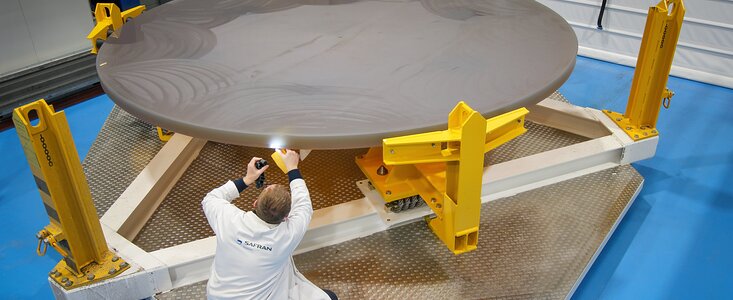Zprávy
ELT Tertiary Mirror Takes Shape
31. ledna 2020
ESO’s Extremely Large Telescope (ELT), the world’s biggest eye on the sky, will have a pioneering five-mirror optical system that will allow it to unveil the Universe in unprecedented detail. The tertiary mirror in this system, M3, has completed a key production stage and has now been delivered to French company Safran Reosc for final polishing.
Each of the mirrors on the ELT presents a significant technological challenge, with extreme precision required at each production stage to ensure flawless optical quality. The German company SCHOTT produced the mirror blank for M3 — a cast block of a glass-ceramic material known as ZerodurⓇ measuring more than four metres from edge to edge and weighing in at over three tonnes. After casting and machining the M3 blank to its approximate shape, SCHOTT delivered the mirror to Safran Reosc, who will now grind and polish it to a precision of 15 nanometres across the entire optical surface.
M3 is a notable feature of the ELT. Most large telescopes, including ESO’s Very Large Telescope (VLT) and the NASA/ESA Hubble Space Telescope, use just two curved mirrors to form an image, with a small, flat, tertiary mirror sometimes introduced to divert the light to a convenient focus. However, in the ELT the tertiary mirror also has a curved surface, as the use of three curved mirrors delivers a better image quality over a larger field of view than would be possible with a two-mirror design. This design will allow the ELT to image the night sky with unprecedented quality.
The five mirrors on the ELT all have different shapes, sizes and roles. The primary, M1, is the most spectacular, a giant 39-metre concave mirror made up of 798 hexagonal segments, which will collect light from the night sky and reflect it to the secondary mirror, M2. Measuring 4.2 metres across and hanging above M1, M2 will be the largest secondary mirror ever employed on a telescope, as well as the largest convex mirror ever produced. It will reflect light back down to M3, which in turn will relay it to an adaptive flat mirror (M4) above it. This fourth mirror, which will be the largest adaptive mirror ever made, will adjust its shape a thousand times a second to correct for distortions caused by atmospheric turbulence. M5, a flat tiltable mirror, will then stabilise the image and send it to the instruments.
Kontakty
Bárbara Ferreira
ESO Public Information Officer
Garching bei München, Germany
Tel: +49 89 3200 6670
Cell: +49 151 241 664 00
Email: pio@eso.org
O zprávě
| Id: | ann20003 |




